|
St. Peter's Square
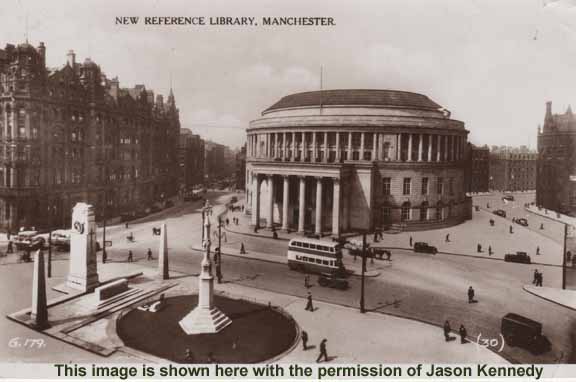 In the 18th Century the
area
where St. Peter's Square stands today was an open
field. In 1788
St Peter's Church was built here on the edge of
the town
centre.
 On August 16, 1819 60,000 people assembled on nearby St Peter's Field to hear Henry Hunt talk about the reform of the House of Commons. The City Magistrate, worried about the meeting, called in the troops and mounted soldiers rode into the crowd. The so called "Peterloo Massacre" resulted in the death of 11 people and the injury of 140 more. St Peter's Church
suffered from
a decline in the local population in the 19th Century
and it was
demolished in 1907. The square was created at that
time and a
cross was erected to commemorate the church.
 Today the square is
dominated
by the Central Library that was built in 1934.
 Four years later
the Town Hall Extension was added next to the library.
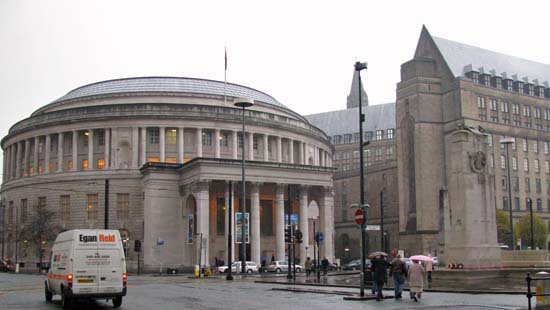 Below is an aerial view of the square from 1956.  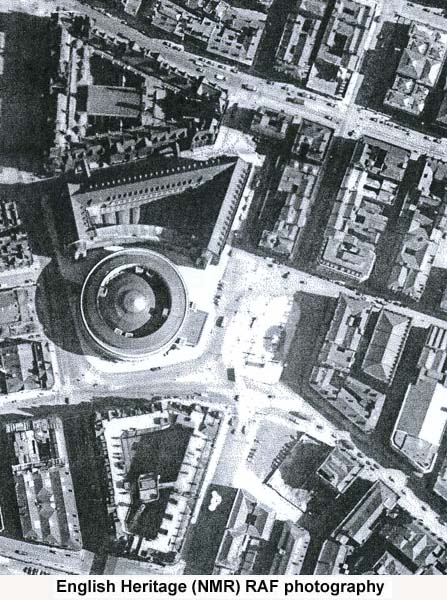 The east side of the
square is
dominated by a dreadful concrete and
glass building called Elizabeth House that was
completed in 1960.
It was apparently meant to be clad in stone but for
financial reasons
that never happened. When I took this picture in
2008 most of the
shops on the street level were closed and an article
in the Manchester
Evening News dated January 29, 2008, indicates that a
major
redevelopment of Elizabeth House is on the cards.
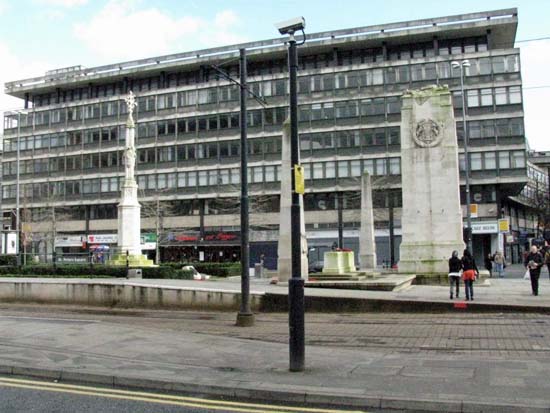  "Nicholas Whipp, partner at GVA Grimley, which has been advising the fund on the future of Elizabeth House, said: "This will be a landmark decision for the core of Manchester and is another sign of the vital regeneration of the central area. Subject to planning, a building in excess of 350,000 sq ft could be located on the site, giving floorplates upwards of 25,000 sq ft in what is now regarded as the prime core of the city. "The building will fall in with the regeneration of St Peter's Square and the important civic buildings of the town hall and Central Library. It is envisaged that the building will be available by 2011." Elisabeth house was demolished in
2013 to be replaced by 1 St Peters Square.
  The Midland Hotel stands on the south end of the square. It is a railway hotel built by the Midland Railway as the counterpart to the St. Pancras Hotel at the other end of the railway, in London. The designer was the Midland Railway's architect Charles Trubshaw. Construction began 1893 and it was completed 5 years later. Reflecting its role as a railway hotel it had a covered walkway from Central Station to the Windmill Street entrance.  The ground floor is built of a pink granite from Peterhead interlaced with bands of a darker Shap granite. The upper floors are built of brick faced with burmantoft terracotta. There is nothing plain about the hotel. There is a great deal of decoration made from glazed terracotta.  It has always been one of Manchester's premier hotels and a plaque in the entrance way commemorates the fact that it was here that Henry Royce and Charles Stewart Rolls first met.  Central Station closed in 1963 so any role as a railway hotel was clearly irrelevant. The hotel has changed hands a number of times over the years. At one time it was a Holiday Inn Crown Plaza but today it belongs to the Q-Hotels chain. The owners say this of the Midland: "Following a £15 million refurbishment, this grand establishment effortlessly mixes decadent glamour with four-star, twenty-first century sophistication. Fourteen suites and 298 en-suite bedrooms of award-winning design offer guests all the facilities one would expect in a hotel of this calibre."  In the island in the centre of the square is the Cenotaph designed by Edwin Lutyens, the designer of the Cenotaph in Whitehall in London. It was completed in time for the Allied Victory Parade in 1919. A number of similar memorial structures were created Lutyens around the country including this one that stands in St. Peter's Square in Manchester. Built of portland stone it is topped by a sculpture of the unknown soldier draped in his greatcoat.  In 2014 the Cenotaph was dismantled and moved to a new plaza near the Town Hall.   Nearby are other
memorials to:
- "Our Fallen Comrades - by the British Legion
Manchester" - The Korean
War - "Our Italian Comrades 1915 - 1918" and "To the
honour and memory
of Mancunians who have given their lives in other
conflicts since 1945"
 A Portland stone cross by L. C. Howitt stands behind the Cenotaph. It was erected to commemorate the fact that St. Peter's Church once stood nearby.   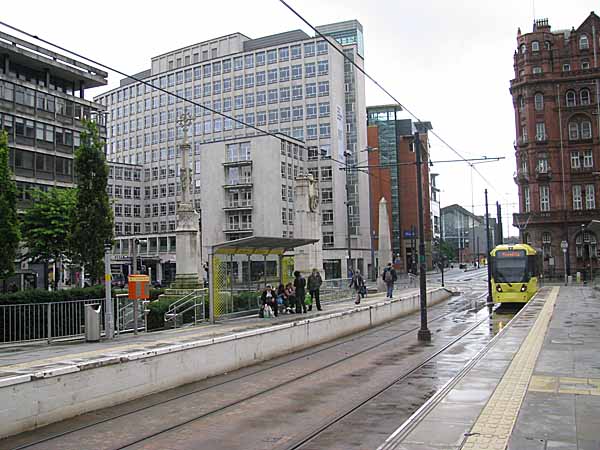  |